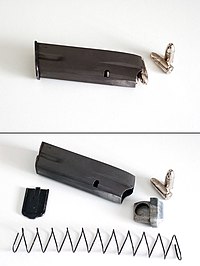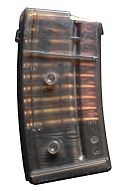Magazine (firearms)


A magazine (also called a mag or, commonly but incorrectly, especially when removable, a clip) is an ammunition storage and feeding device within or attached to a firearm. Magazines may be integral to the firearm (fixed) or removable (detachable).
The cartridges in the magazine are loaded into the firearm either automatically or manually depending on the type of gun, but almost always by a spring. Some magazines can in turn be loaded by a clip; magazine and clip are not synonymous terms. The belt of linked ammunition used by most machine guns is an ammunition feeding device that is not a magazine, since it does not operate by feeding rounds out of a container.
The most common type of magazine is the detachable "box" type. Other types include the drum magazine, sometimes used with the Thompson submachine gun, the "pan" magazine of the Russian DP-28 machine gun, and the fixed "tube" magazine found on many lever-action and semi-automatic rifles and pump-action shotguns.
A particular firearm may use a variety of types of magazine, with some accepting both drum and box magazines of varying sizes, for example.
Magazine types
Tubular
Many of the first repeating rifles, particularly lever-action types, used a tubular magazine which stored cartridges end-to-end inside of a spring-loaded tube typically running parallel to the barrel, although some early repeating rifles had tube magazines in the buttstock. This type of magazine is usually fixed to the firearm, meaning that it cannot be removed easily. The tubular magazine was made obsolete for military purposes with the introduction of pointed "Spitzer" bullets, which risk igniting cartridges stored in the magazine as the pointed bullet impacts the primer of the centerfire cartridge ahead of it during recoil. Tubular magazines can still be found today, commonly in shotguns or firearms designed to use round-nose, flat-nose, or otherwise soft-pointed bullets. Such magazines can also be found in some rim-fire cartridge rifles intended for 22 Long Rifle cartridges. Some believe that tubular magazines tend to affect the harmonics of the barrel negatively, limiting the potential accuracy of the rifle.
Box
The most popular type of magazine in modern rifles and handguns, the box magazine stores cartridges in a parallel column, or stack, one above the other. This allows the bullets of the cartridges stored in the magazine to retain a pointed shape, which contributes to the consistent accuracy of the firearm. Cartridges are fed into the loading position via pressure provided by a spring beneath the cartridge stack. Box magazines may be built into the firearm (internal, integral, or fixed) or may be removable (detachable).
- An internal box magazine (also known as an integral, fixed, or if not visible, blind box magazine) is built into the firearm and not easily removable. This type of magazine is found most often on most pre-WWII military bolt-action rifles, as well as most modern bolt-action hunting rifles. An internal box magazine is usually loaded through the action, usually one round at a time. Military rifles utilized stripper clips or chargers, allowing multiple rounds to be loaded at once. Some internal box magazines utilize en-bloc clips, which are loaded into the magazine along with the ammunition and are ejected from the firearm along with the last spent case. Pistol magazines often fit entirely inside the gun, but they are detachable and so fall into the second category.

- A detachable box magazine is a self-contained magazine, capable of being loaded or unloaded while detached from the host firearm. They are attached via a slot in the receiver of the firearm, usually below the action. When the magazine is empty, it can simply be detached from the firearm and replaced by another full magazine. This significantly speeds the process of reloading the firearm, allowing the operator quick access to a relatively large amount of ammunition in a relatively short span of time. This type of magazine is common in most modern firearms and may be straight or curved, the curve necessary if the rifle uses rimmed ammunition or bottlenecked ammunition with a tapered case. In some situations, two or more detachable box magazines may be taped or otherwise attached together, allowing for faster access to a full reload. Magazines for the SIG 550 family of rifles have integrated attachment points for this purpose.
There are, however, exceptions to these rules. The Lee-Enfield rifles had a detachable box magazine only to facilitate cleaning. Others like the Breda Modello 30 had a fixed protruding magazine, which on first examination resembles a conventional detachable box, but are in fact loaded with clips. Furthermore, many rifles derived from hunting models have detachable blind magazines.
Rotary
The rotary or spool magazine consists of a star-shaped rotor, or sprocket, actuated by a torsion spring. The magazine may be fixed or detachable. Cartridges fit between the teeth of the sprocket, which is mounted on a spindle parallel to the bore axis, with the torsion spring providing the pressure necessary to rotate the rounds into the feeding position. Rotary magazines are usually of low capacity, from five to ten rounds, depending on the cartridge used.
The rotary magazine was first used in the Mannlicher-Schönauer rifles and is still used in a few modern firearm designs, most notably the Ruger 10/22 and the Steyr SSG 69.
Drum
Used in several light machine guns, submachine guns, and shotguns, a moving partition within a cylindrical chamber forces loose rounds into an exit slot, with the cartridges being stored parallel to the axis of rotation. After loading of the magazine, a wound spring or other mechanical force moves the partition against the rounds. The cylindrical design allows for larger capacity than boxes, without growing to excessive length, though the more complicated mechanism can lead to reliability problems. Many drum-fed firearms can also load from conventional boxes, such as the Russian RPK light machine gun and the American Thompson submachine gun. Other weapons, such as the Pancor Jackhammer and DAO-12 shotguns are specifically designed for a drum feed and cannot use boxes.
Dual Drum magazines such as the 90 rounder and the Beta C-Mag are also available. They consist of two independent single column drums which feed into a double column arrangement between the two drums. These magazines are designed to increase the capacity of firearms originally designed to use detachable box magazines.
Pan
Often referred to as a drum magazine, the pan magazine differs from other drum magazines in that the cartridges are stored perpendicular to the axis of rotation, rather than parallel, and are usually mounted on top of the firearm. This type is used on the American-180 submachinegun, the Lewis Gun, and the Degtyarev light machine gun.
Helical
Helical magazines extend the drum magazine design so that rounds follow a spiral path, allowing for a very large ammunition capacity in a compact package. They have been used on the Calico 960 and Bizon submachine guns, but require a complex mechanism.
Belts
Another type of feeding system generally used in machine guns is the belt. It is not itself a magazine, but serves the same purpose of delivering rounds of ammunition to the chamber. Belts differ from magazines in that the machine gun actually draws the next round into the chamber with the recoil or gas energy from the previous round fired. Belts are commonly held in boxes that are directly attached to the weapon, making them more closely resemble magazines.
